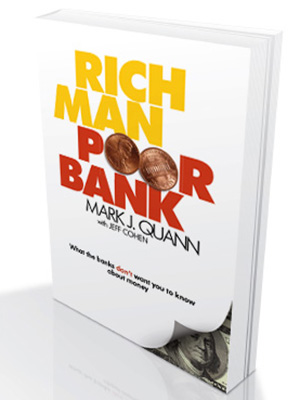Wisconsin Rapids Top 25 Ways an IUL can Secure Your Financial Future: And Build a Tax-Free Family Bank!
So…I finishing up my 3rd book today! Wow, I remember when I started writing my first book in 2009…it took me 5 years to finish it! Rich Man Poor Bank was born! And once again, in my new book, I couldn’t resists going on a tangent about the megabanks and the many ways to have the banks pay you for doing business with them–while using credit unions for your checking and savings account, and credit union-issued credit cards to reduce interest and fees!
Oh ya, this is a book about an unfamilar strategy called “IUL.”
If you are not familiar with Index Universal Life (IUL) insurance and how you can use it to build your own Tax-Free Family Bank…email “chapter 6” to Opole 10ways@remiigroup.com and we will send you Chapter 6 from “Top 10 Ways to Avoid Taxes.” It defines IUL and my introduction to it in 2006.
Here you go!
—
PART TWO: 21 Ways to Build it!
#14. Build a Tax-Free Family Bank
Okay, I’ll try not to go on a tangent about banks for too long! If you want to know what I concluded when researching the “alternatives to saving in the banks,” you can read my first book, Rich Man Poor Bank. What that book demonstrates is: “What the banks don’t want you to know about money.” I believe the most important lesson in the book is that it reveals the inverse relationship between bank profit and financial literacy. In other words, the higher a person’s financial education, the less money the banks will earn from them during their life.
Financial Education ⇑ = Bank Profit ⇓
Financial Education ⇓ = Bank Profit ⇑
And since these publicly traded megabanks have one primary goal – “Maximizing profit for their shareholders” – it is imperative that the banks must keep Americans financially illiterate to ensure they maximize their profit. The banks’ mantra, which has not changed during my lifetime, is:
“Saving money and getting good credit will lead to your financial security.”
I concluded something quite different:
“Saving money and getting good credit makes bankers wealthy!”
Let’s illustrate one of the most important lessons in “Rich Man Poor Bank,” specifically, the “RULE OF 72.” The rule of 72 calculates how long it will take for your money to double when earning a particular rate of interest:
Simply divide the rate you are earning into the number 72.
For example, if earning 1% on a savings account, divide 1 into 72 and you will get the number 72. So “72” is the amount of years it will take for your money to double when earning 1% return on bank savings.
How about if your bank is not paying 1%, rather is paying you 0.1%? Take out your calculator and you will find it takes 720 years for your money to double.
At .02% it takes 3,600 years to double your money.
The same rule also applies for how long it takes for debt to double. For example, many Americans carry credit card debt at 16% – 24%.
At 16%, credit card debt doubles every 4 ¼ years.
At 24%, credit card debt doubles every 3 years.
What is most important to understand is that the banks judge your credit worthiness based on your credit score. The higher the score, the less risk and the better rates you can get. The lower the score, the more risk, and the rates will be higher.
This model ensures that when you need it most, perhaps when you lost a job and find yourself in financial hot water, the banks will hammer you the hardest, with the highest interest rates… as you are not credit worthy without a job. And, when you have a job and are doing well financially and don’t need the money, the banks are happy to lend it to you, again, only when you don’t really need it.
At the same time, the “financial gurus” and talking heads on TV recommend:
“Keep six-to-twelve months of savings in your bank account for emergency funds.”
And the megabanks are happy to help you save it — resulting in 11 billion+ in bank savings, CDs and money market accounts. The banks are happy to comply and put that money hard to work for them.
What is important to understand is that these “rules” were built specifically by the banks, for the benefit of the banks, and to enrich only the banks.
How about you create your own rules?
How about having the ability to borrow at the lowest rates, regardless of your credit score, or even if you don’t have a job or income?
What if you never again needed to “keep six-to-twelve months of savings in your bank account for emergency funds” and your money was working hard for you rather than the banks?
As we covered earlier in this book, the funds in an IUL grow free of state, federal and capital gains taxes. You can access these funds with no penalties, no income, no age restrictions, and no taxes.
There are certain IULs that even allow you to use the cash value as collateral, and you can give yourself a tax-free loan against it, while keeping the full amount of funds “invested” and growing inside the IUL.
For example, if you had $200,000 of cash value in your IUL and you wanted to borrow $100,000 to purchase an investment property or put towards a business – really, you can use it for anything you want – you can take a loan of that $100,000 (no taxes on loans) while still having the full $200,000 to grow in the market, tax-free and risk-free!
Yes, it is like your IUL becomes your own personal Tax-Free Family Bank!
I’m assuming you remember my #1 Rule for Investing?
Here is how I personally structure my finances…so the megabanks don’t get to use my money, and I can use OPM in all my investing:
For Banking:
I use a credit union as they are not-for-profit. They have members (you) rather than shareholders, so they don’t have the goal of maximizing shareholder value. Both my checking account and my business account are held at the local credit union. I don’t pay fees for either.
I have a credit card from my credit union that is around 9% interest. And most importantly, I can take a cash from this card with no fees, and they will lend it to me at the 9% interest rate even on a cash advance. This is a different from a bank-issued credit card which would first charge a 5% cash advance fee, plus 24% annual interest, or more.
Let’s illustrate the difference in costs if I needed to borrow, let’s say $10,000 in a bind. And I only want to borrow for a month and didn’t want to liquidate any investments to do so.
At my credit union, I would simply logon to the credit union App and transfer the $10,000 from my credit card into my checking account. Again, no fees would apply.
My megabank-issued card would first charge a cash advance fee of 5%, or $500.
Then they would begin charging 24% interest on the amount borrowed.
For one month, that would be about 2%, or $200.
My credit union would charge 9% annually, so for one month that is about 0.75%, or $75.
Total bank fees and interest when borrowing $10,000 for one month:
If borrowing from a megabank = $700
If borrowing from my credit union = $75
Because of this “backup emergency fund,” I save very little in the credit union, I don’t have anything in my savings account, and keep most of my money invested in other places working hard for me.
I also have a megabank-issued credit card I use for my business. I charge it up for business expenses and pay it down to zero each month, so I also pay zero in interest. I earn the airmiles/perks and money back, so the megabank pays me to use their money.
Thanks, credit union! And thanks, bank!
My financial education ⇑ = Bank Profit ⇓
For Investing:
I have a brokerage account and I can invest in municipal bond ETFs and receive tax-free dividends. (I can also buy other ETFs, stocks, etc.)
I also am approved for “margin” which gives me the ability to borrow at super low interest rates for additional investing, with no credit check and no income verification. The current rate to borrow on margin is 2.55%.
So, my money is always working hard for me, earns tax-free dividends, and is fully liquid. That is another source for emergency funds if I ever need it.
For Insurance:
I have a large 30-year convertible term insurance policy to keep my life insurance costs down as much as possible.
I have a “next generation IUL” with an LTC rider, and a 20% cap, and the ability to borrow at low interest rates, if needed… and with no credit check or income verification.
It is possible to have many years of reserves growing without risk and taxes, so that you too can weather the storm in any economy.
As you can see, I have the option to use OPM in all my investing when I see an opportunity, and I don’t need to apply with a banker if I want to borrow. I can borrow for any reason at all.
To summarize:
I have good credit, but don’t need it to borrow. And I don’t listen to the talking heads on TV, and “Keep six-to-twelve months of savings in my bank account for emergency funds.”
Click here for more info on all of Marks books on Amazon.



 Mark Quann is an entrepreneur with a belief in the liberating power of financial education and a campaign to slash the toxic influence of big banks and credit companies.
Mark Quann is an entrepreneur with a belief in the liberating power of financial education and a campaign to slash the toxic influence of big banks and credit companies. 





No comments yet.